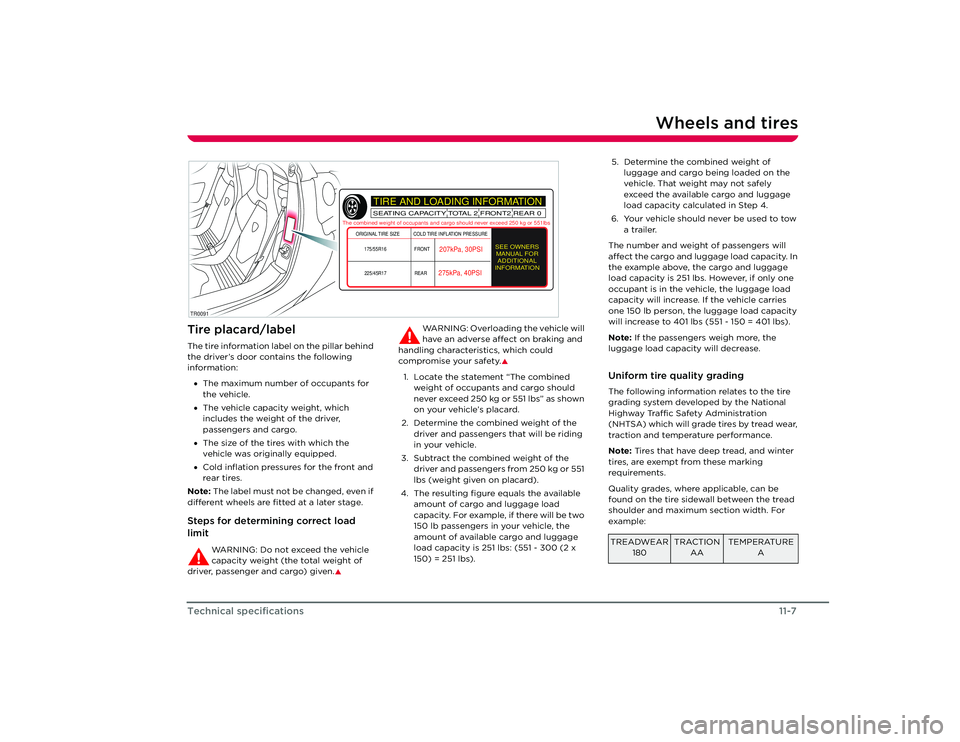load capacity TESLA ROADSTER 2008 Owners Manual
[x] Cancel search | Manufacturer: TESLA, Model Year: 2008, Model line: ROADSTER, Model: TESLA ROADSTER 2008Pages: 115, PDF Size: 46.35 MB
Page 97 of 115

Wheels and tires
11-7
Technical specifications
Tire placard/labelThe tire information label on the pillar behind
the driver’s door contains the following
information:
• The maximum number of occupants for
the vehicle.
• The vehicle capacity weight, which
includes the weight of the driver,
passengers and cargo.
• The size of the tires with which the
vehicle was originally equipped.
• Cold inflation pressures for the front and
rear tires.
Note: The label must not be changed, even if
different wheels are fitted at a later stage.Steps for determining correct load
limit
WARNING: Do not exceed the vehicle
capacity weight (the total weight of
driver, passenger and cargo) given.
�S
WARNING: Overloading the vehicle will
have an adverse affect on braking and
handling characteristics, which could
compromise your safety.
�S
1. Locate the statement “The combined weight of occupants and cargo should
neve r exce e d 2 50 kg or 5 51 l bs ” as s h ow n
on your vehicle’s placard.
2. Determine the combined weight of the driver and passengers that will be riding
in your vehicle.
3. Subtract the combined weight of the driver and passengers from 250 kg or 551
lbs (weight given on placard).
4. The resulting figure equals the available amount of cargo and luggage load
capacity. For example, if there will be two
150 lb passengers in your vehicle, the
amount of available cargo and luggage
load capacity is 251 lbs: (551 - 300 (2 x
150) = 251 lbs).
TR0091
TIRE AND LOADING INFORMATIONSEATING CAPACITY TOTAL 2 FRONT2 REAR 0
SEE OWNERSMANUAL FOR ADDITIONAL
INFORMATION
The combined weight of occupants and cargo should never exceed 250 kg or 551lbs
ORIGINAL TIRE SIZE
COLD TIRE INFLATION PRESSURE
175/55R16
225/45R17 FRONT
REAR
207kPa, 30PSI
275kPa, 40PSI
5. Determine the combined weight of luggage and cargo being loaded on the
vehicle. That weight may not safely
exceed the available cargo and luggage
load capacity calculated in Step 4.
6. Your vehicle should never be used to tow a trailer.
The number and weight of passengers will
affect the cargo and luggage load capacity. In
the example above, the cargo and luggage
load capacity is 251 lbs. However, if only one
occupant is in the vehicle, the luggage load
capacity will increase. If the vehicle carries
one 150 lb person, the luggage load capacity
will increase to 401 lbs (551 - 150 = 401 lbs).
Note: If the passengers weigh more, the
luggage load capacity will decrease.Uniform tire quality gradingThe following information relates to the tire
grading system developed by the National
Highway Traffic Safety Administration
(NHTSA) which will grade tires by tread wear,
traction and temperature performance.
Note: Tires that have deep tread, and winter
tires, are exempt from these marking
requirements.
Quality grades, where applicable, can be
found on the tire sidewall between the tread
shoulder and maximum section width. For
example:TREADWEAR 180
TRACTION AA
TEMPERATURE A
Roadster OHB.book Page 7 Th ursday, October 2, 2008 8:59 AM
Page 103 of 115

Wheels and tires
11-13
Technical specifications
Wheels and tires glossaryAccessory weightThe combined weight (in excess of those
items replaced) of items available as factory
installed equipment.BeadThe inner edge of a tire that is shaped to fit to
the rim and form an air tight seal. The bead is
constructed of steel wires which are
wrapped, or reinforced, by the ply cords.Cold tire pressureThe air pressure in a tire which has been
standing in excess of three hours, or driven
for less than one mile.Curb weightThe weight of a standard vehicle, including
any optional equipment fitted, and with the
correct fluid levels.Gross vehicle weightThe maximum permissible weight of a vehicle
with driver, passengers, load, luggage, and
equipment.kPa (kilo pascal)A metric unit used to measure pressure. One
kilo pascal equals approximately .145 psi.Maximum inflation pressureThe maximum pressure to which the tire
should be inflated. This pressure is given on
the tire side wall in lbf/in
2. Note: This pressure is the maximum allowed
by the tire manufacturer. It is not the pressure
recommended for use.
Maximum loaded vehicle weightThe sum of curb weight, accessory weight,
vehicle capacity weight, and production
options weight.Production options weightThe combined weight of options installed
which weigh in excess of 3 lb more than the
standard items that they replaced, and are
not already considered in curb or accessory
weights. PSI (lbf/in
2)
Pounds per square inch, unit of measure for
pressure.RimThe metal support for a tire, or tire and tube,
upon which the tire beads are seated.Vehicle capacity weightThe number of seats multiplied by 150 lb plus
the rated amount of load/luggage.
Roadster OHB.book Page 13 Thursday, October 2, 2008 8:59 AM